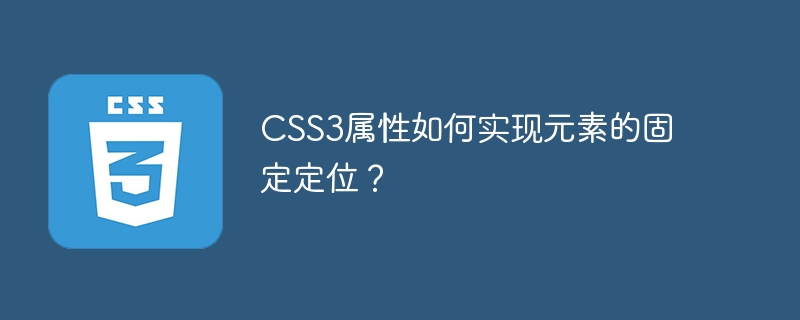Home >Web Front-end >CSS Tutorial >How do CSS3 properties implement fixed positioning of elements?
How do CSS3 properties implement fixed positioning of elements?
- WBOYWBOYWBOYWBOYWBOYWBOYWBOYWBOYWBOYWBOYWBOYWBOYWBOriginal
- 2023-09-09 10:25:491903browse

How do CSS3 properties achieve fixed positioning of elements?
In web development, fixed positioning is a common layout method, which is often used to achieve special effects such as floating or top navigation bars. CSS3 provides us with some properties that can help us achieve fixed positioning of elements.
1. Position attribute
In CSS, the position attribute is used to define the positioning method of elements. Common values include static, relative, absolute and fixed.
- static: The default positioning method, elements are arranged according to the normal document flow.
- relative: Relative positioning, the element is positioned relative to its normal position. The position of the element can be adjusted by setting the top, bottom, left, and right attributes.
- Absolute: Absolute positioning. The element is positioned relative to its nearest non-statically positioned parent element. If it is not found, it is positioned relative to the document.
- fixed: Fixed positioning, the element is positioned relative to the viewport, that is, the element will be fixed at a certain position on the page as the scroll bar scrolls.
2. Use the fixed attribute to achieve fixed positioning
The following is an example of using the fixed attribute to achieve fixed positioning:
<!DOCTYPE html>
<html>
<head>
<style>
.header {
position: fixed;
top: 0;
left: 0;
width: 100%;
background-color: #333;
color: #fff;
padding: 10px;
text-align: center;
}
.content {
margin-top: 60px;
}
</style>
</head>
<body>
<div class="header">固定导航栏</div>
<div class="content">
<p>这是页面的内容。</p>
</div>
</body>
</html>In the above example, we use The position: fixed attribute is used to define a fixed-positioned navigation bar. Top: 0 and left: 0 are set so that the navigation bar is located in the upper left corner of the page. width: 100% makes the navigation bar the same width as the browser window. The background-color and color properties are used to set the background color and text color of the navigation bar.
In order to prevent the content from being blocked by the navigation bar, we set a value of 60px for the margin-top attribute in the content class and move the content down 60 pixels.
3. Use the z-index attribute to control the hierarchy
Sometimes, using fixed-positioned elements on the page may block other elements. At this time, we can use the z-index attribute to control the level of the element.
<!DOCTYPE html>
<html>
<head>
<style>
.top-banner {
position: fixed;
top: 0;
left: 0;
width: 100%;
height: 100px;
background-color: #333;
color: #fff;
padding: 10px;
text-align: center;
z-index: 999;
}
.content {
margin-top: 120px;
text-align: center;
}
.bottom-banner {
position: fixed;
bottom: 0;
left: 0;
width: 100%;
height: 100px;
background-color: #333;
color: #fff;
padding: 10px;
text-align: center;
z-index: 999;
}
</style>
</head>
<body>
<div class="top-banner">顶部横幅</div>
<div class="content">
<p>这是页面的内容。</p>
</div>
<div class="bottom-banner">底部横幅</div>
</body>
</html>In the above example, we used the z-index attribute to control the level of the two banner elements. The larger the value of z-index, the higher the level of the element. Here, we set z-index: 999 for the banner elements so that they are in front of other elements and not obscured by other elements.
Summary:
The position attribute and z-index attribute of CSS3 can help us achieve fixed positioning of elements. By setting the position: fixed attribute, we can fix the element at a certain position on the page, and use the z-index attribute to control the element's level to avoid being obscured by other elements. Flexible application of these attributes allows us to achieve a variety of fixed positioning effects.
The above is the detailed content of How do CSS3 properties implement fixed positioning of elements?. For more information, please follow other related articles on the PHP Chinese website!
Related articles
See more- In html5, set or return the attribute autoplay of whether the audio and video will start playing after loading.
- What are the position attributes of css? Introduction to position attribute and usage in css
- What to do if docker stop container fails
- What to do if the top command in Linux is not fully displayed

